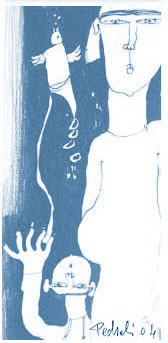Sperm aneuploidy and recurrent pregnancy loss.
Bernardini, L.M., Costa, M., Bottazzi, C. , Gianaroli, L., Magli, C., Francioso, R., Conte, N., Ragni, N. Reprod. Biomed. Online 2004, 9:312-320.
|
Chromosomal abnormalities are an important cause of recurrent pregnancy loss (RPL). Though most of them originate in maternal gametes or at early stages of embryogenesis, it is possible that increased sperm aneuploidy may be responsible for certain cases of RPL and a subject of study.
METHODS: Experiments of double target in situ hybridization (ISH) were performed separately for chromosomes 1-17, 8-18 and sex chromosomes on sperm samples from 20 couples suffering from three or more recurrent first trimester abortions. For a subset of this study population, additional experiments of multicolor FISH for chromosomes 4, 7, 12, 13, 15, 18, 21, and 22, were performed on the bases of the available data from abortive tissue karyotyping. Eleven out 20 patients had a total normal motile count (TNMC) >= 5 x 106 (group A) (normozoospermic) while the other 9 had a TNMC <= 5 x 106 (poor semen quality) (group B). Normal semen samples were donated from 6 healthy and fertile men and used as controls. Mean maternal age was < 35 years.
RESULTS: A markedly high rate of sperm disomy was scored only in 2 out of 20 patients (10% of the cases). In one of these sex chromosomes - hyperhaploidy was 14.5% and in the other disomy for chromosome 17 was 15.5%. One of these two men belonged to group A and the other to group B. For other three patients, the cumulative disomy rates for chromosomes 1, 17, 8, 18, X and Y also increased but at a lower level (7.8%-9.5%). For the remaining 15/20 patients (75%) the frequency of sperm aneuploidy moderately increased or was normal. Men with RPL and poor semen quality (TNMC < 5 x 106) had baseline sperm aneuploidy and diploidy rates higher than men with normal semen parameters (with or without RPL). Trisomies found in abortions were never found to be associated with significant changes of sperm disomy.
CONCLUSIONS: Using probes for chromosomes 1, 17, 8, 18, X, and Y, significantly elevated frequencies of sperm aneuploidy (not diploidy) were found only in 10% of men with history of RPL. Their rate of sperm aneuploidy (disomy + nullisomy) (30%-34%) could be reasonably suspected to be the origin of aneuploid conceptions and recurrent abortions. For all the other men, changes in sperm aneuploidy were not so high to significantly influence the risk of RPL. Poor semen quality resulted per se to impact negatively on the baseline frequency of sperm aneuploidy and diploidy thus making the interpretation of clinical data being more difficult.
|

